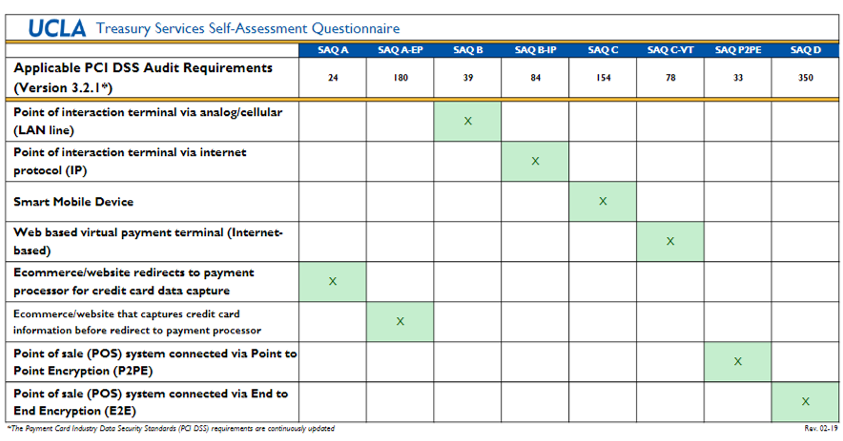Overview
The University supports credit card payments to increase productivity in collections and to help improve customer service. Departments interested in becoming a merchant are required to fill out the New Merchant form.
Requirements
- Completion of New Merchant Form
- Completion of Policies & Procedures
- Self-Assessment Questionnaire - PCI DSS enforces various requirements per solution type. Please see the types below and the links to their corresponding forms.

SAQ A has been developed to address requirements applicable to merchants whose cardholder data functions are completely outsourced to validated third parties, where the merchant retains only paper reports or receipts with redacted data.
SAQ A-EP has been developed to address requirements applicable to e-commerce merchants with a website(s) that does not itself receive cardholder data but which does affect the security of the payment transaction and/or the integrity of the page that accepts the consumer’s cardholder data.
SAQ A-EP merchants are e-commerce merchants who partially outsource their e-commerce payment channel to PCI DSS validated third parties and do not electronically store, process, or transmit any cardholder data on their systems or premises.
SAQ B has been developed to address requirements applicable to merchants who process cardholder data only via imprint machines or standalone, dial-out terminals. SAQ B merchants may be either brick-and-mortar (card-present) or mail/telephone order (card-not-present) merchants, and do not store cardholder data on any computer system.
SAQ B-IP has been developed to address requirements applicable to merchants who process cardholder data only via standalone, PTS-approved point-of-interaction (POI) devices with an IP connection to the payment processor. An exception applies for POI devices classified as Secure Card Readers (SCR); merchants using SCRs are not eligible for this SAQ.
SAQ B-IP merchants may be either brick-and-mortar (card-present) or mail/telephone-order (card-not-present) merchants, and do not store cardholder data on any computer system.
SAQ C has been developed to address requirements applicable to merchants whose payment application systems (for example, point-of-sale systems) are connected to the Internet (for example, via DSL, cable modem, etc.).
SAQ C merchants process cardholder data via a point-of-sale (POS) system or other payment application systems connected to the Internet, do not store cardholder data on any computer system, and may be either brick-and-mortar (card-present) or mail/telephone-order (card-not-present) merchants.
SAQ C-VT has been developed to address requirements applicable to merchants who process cardholder data only via isolated virtual payment terminals on a UCLA computer connected to the Internet.
A virtual payment terminal is web-browser-based access to an acquirer, processor, or third-party service provider website to authorize payment card transactions, where the merchant manually enters payment card data via a securely connected web browser. Unlike physical terminals, virtual payment terminals do not read data directly from a payment card. Because payment card transactions are entered manually, virtual payment terminals are typically used instead of physical terminals in merchant environments with low transaction volumes.
SAQ P2PE has been developed to address requirements applicable to merchants who process cardholder data only via hardware payment terminals included in a validated and PCI-listed Point-to-Point Encryption (P2PE) solution.
SAQ P2PE merchants do not have access to clear-text cardholder data on any computer system and only enter account data via hardware payment terminals from a PCI SSC-approved P2PE solution. SAQ P2PE merchants may be either brick-and-mortar (card-present) or mail/telephone-order (card-not-present) merchants. For example, a mail/telephone-order merchant could be eligible for SAQ P2PE if they receive cardholder data on paper over a telephone, and key it directly and only into a validated P2PE hardware device.
SAQ D for Service Providers applies to all service providers defined by a payment brand as being SAQ-eligible, but do not meet the criteria for any of the other SAQ questionnaires.
